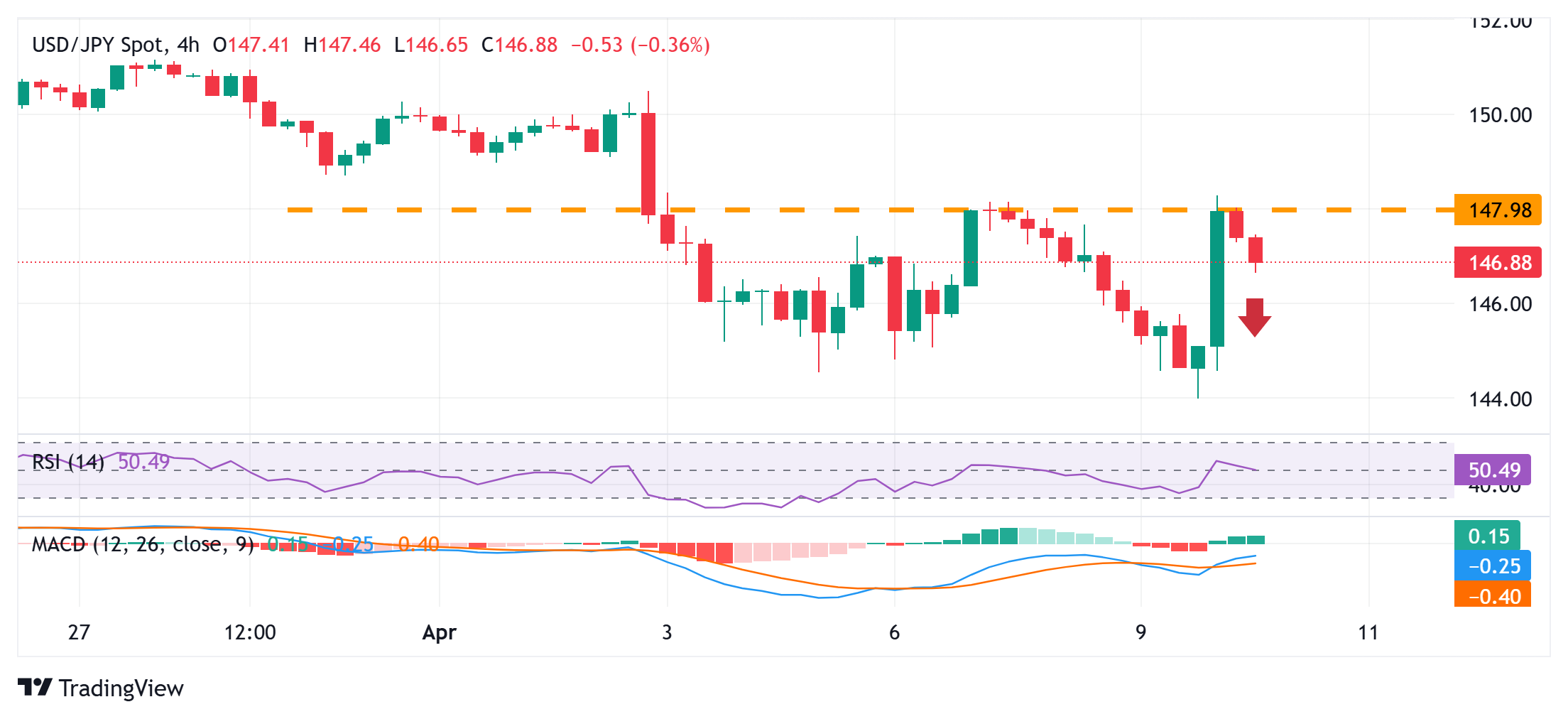The Japanese Yen attracts fresh buyers as stronger PPI reaffirms BoJ rate hike bets.Hopes for a US-Japan trade deal turn out to be another factor benefiting the JPY.A solid recovery in the global risk sentiment could cap gains for the safe-haven JPY.
The Japanese Yen (JPY) sticks to intraday gains led by the stronger-than-expected release of the Producer Price Index (PPI), which keeps the door open for further rate hikes by the Bank of Japan (BoJ). Furthermore, the optimism that Japan might strike a trade deal with the US turns out to be another factor underpinning the JPY. The US Dollar (USD), on the other hand, fails to capitalize on the overnight modest recovery against its Japanese counterpart and drags the USD/JPY pair drags the USD/JPY pair back below the 147.00 mark during the Asian session on Thursday.
Meanwhile, hawkish BoJ expectations mark a big divergence in comparison to rising bets for multiple rate cuts by the Federal Reserve (Fed) in 2025. This should continue to underpin demand for the lower-yielding JPY and suggests that the path of least resistance for the USD/JPY pair remains to the downside. However, a turnaround in the global risk sentiment, bolstered by US President Donald Trump’s announcement to pause reciprocal tariffs on most nations, might cap the safe-haven JPY. Traders might also opt to wait for the US consumer inflation figures due later today.
Japanese Yen sticks to bullish bias amid hawkish BoJ expectationsThe Bank of Japan’s preliminary report released earlier this Thursday showed that Japan’s Producer Price Index (PPI) increased by 0.4% in March and rose 4.2% compared to the same time period last year. The readings were higher than consensus estimates and could push up consumer prices, which, in turn, backs the case for further policy tightening by the BoJ and underpins the Japanese Yen. US President Donald Trump agreed to meet Japanese officials to initiate trade discussions after speaking to Japan’s Prime Minister Shigeru Ishiba earlier this week. US Treasury Secretary Scott Bessent’s subsequent comments, saying that Japan may be a priority in tariff negotiations, fueled hopes for a possible US-Japan trade deal and turned out to be another factor that underpins the JPY. The US Dollar rebounded against safe-haven currencies, including the JPY, on Wednesday after Trump declared an immediate 90-day pause on the big tariff increases for most countries. The announcement eased worries about the global economic impact of US trade policies, triggering a sharp rally in equity markets. The S&P 500 soared 9.5% and registered its biggest daily gain since 2008. Meanwhile, the minutes of the March 18-19 FOMC meeting revealed that officials almost unanimously agreed that the US economy was at risk of experiencing higher inflation and slower growth on the back of Trump’s trade tariffs. Policymakers, however, called for a cautious approach to interest rate cuts, forcing investors to trim their bets for more aggressive easing by the Fed.Traders now expect the Fed to wait until June to resume its rate-cutting cycle and are pricing in just 75 basis points of rate reductions by the year-end. The USD bulls, however, seem reluctant and opt to wait for the release of the US inflation figures – the Consumer Price Index (CPI) and the Producer Price Index (PPI) on Thursday and Friday, respectively – before positioning for further gains. USD/JPY could accelerate the fall once the 146.30-146.25 support is broken
From a technical perspective, the USD/JPY pair has been struggling to find acceptance above the 148.00 round figure since the beginning of this week. Moreover, oscillators on the daily chart are holding in negative territory and are still away from being in the oversold zone. This, in turn, favors bearish traders and suggests that the path of least resistance for spot prices remains to the downside. Hence, a subsequent slide towards the 146.30 intermediate support, en route to the 146.00 mark, looks like a distinct possibility. Some follow-through selling would expose the next relevant support near the 145.50 region before the pair eventually drops to the 145.00 psychological mark.
On the flip side, the 147.75 zone, followed by the 148.00 mark, could act as an immediate hurdle ahead of the 148.25-148.30 region, or the weekly high touched on Wednesday. A sustained strength beyond the latter would set the stage for an extension of the previous day’s goodish rebound from sub-144.00 levels, or the lowest since October 2024, and allow the USD/JPY pair to reclaim the 149.00 round figure. The momentum could extend further towards the 149.35-149.40 area en route to the 150.00 psychological mark.
Bank of Japan FAQs
The Bank of Japan (BoJ) is the Japanese central bank, which sets monetary policy in the country. Its mandate is to issue banknotes and carry out currency and monetary control to ensure price stability, which means an inflation target of around 2%.
The Bank of Japan embarked in an ultra-loose monetary policy in 2013 in order to stimulate the economy and fuel inflation amid a low-inflationary environment. The bank’s policy is based on Quantitative and Qualitative Easing (QQE), or printing notes to buy assets such as government or corporate bonds to provide liquidity. In 2016, the bank doubled down on its strategy and further loosened policy by first introducing negative interest rates and then directly controlling the yield of its 10-year government bonds. In March 2024, the BoJ lifted interest rates, effectively retreating from the ultra-loose monetary policy stance.
The Bank’s massive stimulus caused the Yen to depreciate against its main currency peers. This process exacerbated in 2022 and 2023 due to an increasing policy divergence between the Bank of Japan and other main central banks, which opted to increase interest rates sharply to fight decades-high levels of inflation. The BoJ’s policy led to a widening differential with other currencies, dragging down the value of the Yen. This trend partly reversed in 2024, when the BoJ decided to abandon its ultra-loose policy stance.
A weaker Yen and the spike in global energy prices led to an increase in Japanese inflation, which exceeded the BoJ’s 2% target. The prospect of rising salaries in the country – a key element fuelling inflation – also contributed to the move.


AloJapan.com